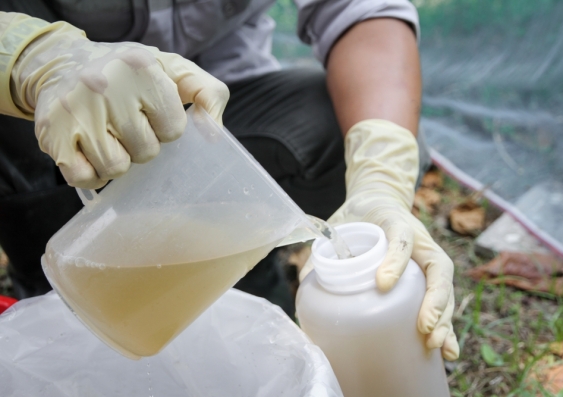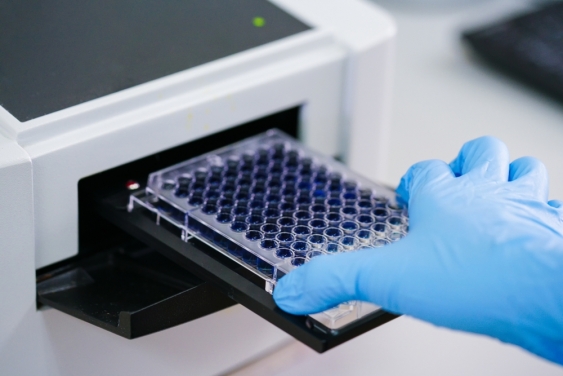创新背景
隐孢子虫是一种微小的寄生虫,可以导致严重的胃肠道疾病,在水源可能被野生和家养动物污染的地方尤其普遍。
长时间以来,检测隐孢子虫通常需要使用昂贵的实验室设备、专门的显微镜和熟练的培训来识别水样中的微生物。
创新过程
新南威尔士大学的Ewa Goldys教授领导了一项研究,该研究使用CRISPR技术更快速、更容易地识别潜在致命的隐孢子虫微生物。
新南威尔士大学生物医学工程研究生院的Ewa Goldys教授和她的团队的研究表明,超灵敏的CRISPR技术可以在现场和使用简单的设备识别样本中微小隐孢子虫的存在。当隐孢子虫被发现时,该系统会在水样中产生独特的荧光。

CRISPR技术已被证明可以使用简单的设备识别现场水样中是否存在有害的隐孢子虫微生物。
这项新技术还可以进一步开发,以改进对其他细菌和病毒的检测,包括可能识别废水样品中的COVID-19。
此外,研究人员认为这项技术可以应用于检测Covid-19,目前从废水样本中得到结果需要长达11个小时,其中大部分时间通常花在将样本运输到所有专业设备所在的实验室上。
新系统在两个半小时内就能给出隐孢子虫的检测结果,研究人员希望这是一项新技术,可以很容易地应用在采集水样的地点。
荧光标记
Goldys教授和她的团队——包括Graham Vesey教授,Yi Li, Fei Deng和Tim Hall——的工作使用了CRISPR技术,可以检测隐孢子虫微生物(称为卵囊)表面的特定蛋白质,然后与之结合。
当在反应混合物中加入荧光剂,然后将其与水样结合,结果是一个可以被标准平板阅读器检测到的清晰信号。

当CRISPR技术用于检测隐孢子虫卵囊表面的特定蛋白质时,可以使用简单的读板器来检测荧光信号。
这些平板阅读器适用于同时对多个样品进行大规模筛选,从而使检测过程更快、更有效。
基于CRISPR/ cas12的系统可以在大约2.5小时内产生结果,最高灵敏度可达每毫升一个隐孢子虫卵囊。
创新关键点
超灵敏的CRISPR技术可以在现场和使用简单的设备识别样本中微小隐孢子虫的存在。当隐孢子虫被发现时,该系统会在水样中产生独特的荧光。
创新价值
这种新方法降低了水质检测的成本,并使其应用范围更广,使水检测更快,更便宜。
Innovative application of CRISPR technology to improve the detection accuracy of harmful microscopic parasites in water
Professor Ewa Goldys of the University of New South Wales led a study that used CRISPR technology to more quickly and easily identify the potentially deadly cryptosporidium organism.
Research by Professor Ewa Goldys and her team at the Graduate School of Biomedical Engineering at the University of New South Wales has shown that the ultra-sensitive CRISPR technology can identify the presence of Cryptosporidium minus in samples both in the field and using simple equipment. When Cryptosporidium is found, the system produces a unique fluorescence in the water sample.
The new technology could also be further developed to improve detection of other bacteria and viruses, including potentially identifying COVID-19 in wastewater samples.
In addition, the researchers believe the technology could be applied to detect COVID-19, which currently takes up to 11 hours to get results from wastewater samples, with most of that time typically spent transporting samples to laboratories where all specialist equipment is located.
The new system gives results for cryptosporidium within two and a half hours, and the researchers hope it is a new technique that could be easily applied at sites where water samples are taken.
Fluorescent tags
The work by Prof Goldys and her team - which includes Prof Graham Vesey, Yi Li, Fei Deng and Tim Hall - uses CRISPR technology, which can detect and then bind to specific proteins on the surface of cryptosporidium microbes, called oocysts.
When a fluorescent agent is added to the reaction mixture and then combined with a water sample, the result is a clear signal that can be detected by a standard plate reader.
These plate readers are suitable for large-scale screening of multiple samples simultaneously, making the testing process faster and more efficient.
The CRISPR/ Cas12-based system can produce results in about 2.5 hours, with a maximum sensitivity of one Cryptosporidium oocyst per milliliter.
智能推荐
PRC2蛋白质调节决定胚胎发育的最初细胞
2022-08-08通过模仿怀孕的第一周观察胚胎细胞,使用胚胎模型探究PRC2蛋白质
涉及学科涉及领域研究方向通过追踪鞘脂新技术发现母乳喂养对婴儿肠道微生物群的影响
2022-08-19研究团队开发了一种新技术,能够跟踪饮食中的鞘脂通过小鼠肠道时的情况,首次发现了拟杆菌和双歧杆菌在母乳中的重要性。
涉及学科涉及领域研究方向生命科学创新 | “CAHS蛋白”研究全新揭示缓步动物在极端脱水条件下的生存机制
2022-10-31与细胞或生物体的干燥保存相关的机制的研究可能对许多未来的应用起作用。新机制的发现有助于找到改善细胞材料和生物分子在干燥状态下保存的方法,延长用于研究的材料的保质期。
涉及学科涉及领域研究方向新型光激活涂层用于杀死细菌
2022-08-04伦敦大学学院(ucl)领导的研究团队开发出了一种可以在低强度的光线下激活,杀死金黄色葡萄球菌和大肠杆菌等细菌的新型涂层。
涉及学科涉及领域研究方向